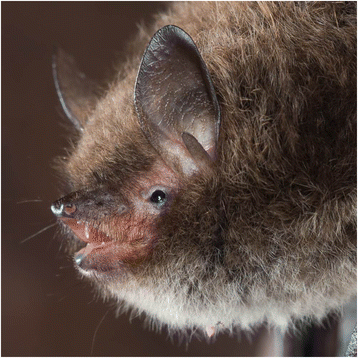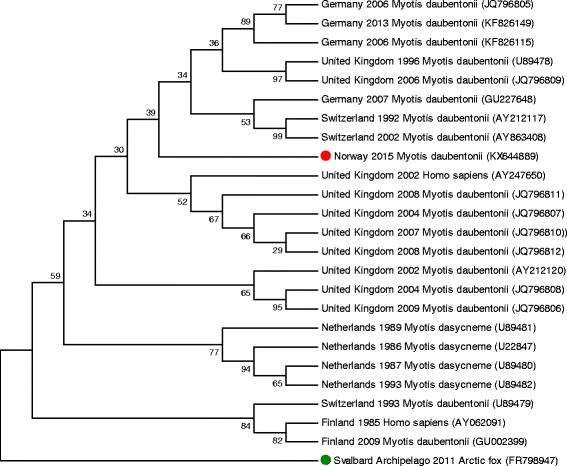First detection of European bat lyssavirus type 2 (EBLV-2) in Norway
- PMID: 28693578
- PMCID: PMC5504624
- DOI: 10.1186/s12917-017-1135-z
First detection of European bat lyssavirus type 2 (EBLV-2) in Norway
Abstract
Background: In Europe, bat rabies is primarily attributed to European bat lyssavirus type 1 (EBLV-1) and European bat lyssavirus type 2 (EBLV-2) which are both strongly host-specific. Approximately thirty cases of infection with EBLV-2 in Daubenton's bats (Myotis daubentonii) and pond bats (M. dasycneme) have been reported. Two human cases of rabies caused by EBLV-2 have also been confirmed during the last thirty years, while natural spill-over to other non-flying mammals has never been reported. Rabies has never been diagnosed in mainland Norway previously.
Case presentation: In late September 2015, a subadult male Daubenton's bat was found in a poor condition 800 m above sea level in the southern part of Norway. The bat was brought to the national Bat Care Centre where it eventually displayed signs of neurological disease and died after two days. EBLV-2 was detected in brain tissues by polymerase chain reaction (PCR) followed by sequencing of a part of the nucleoprotein gene, and lyssavirus was isolated in neuroblastoma cells.
Conclusions: The detection of EBLV-2 in a bat in Norway broadens the knowledge on the occurrence of this zoonotic agent. Since Norway is considered free of rabies, adequate information to the general public regarding the possibility of human cases of bat-associated rabies should be given. No extensive surveillance of lyssavirus infections in bats has been conducted in the country, and a passive surveillance network to assess rabies prevalence and bat epidemiology is highly desired.
Keywords: Daubenton’s bat (Myotis daubentonii); European bat lyssavirus type 2 (EBLV-2); Rabies; fluorescent antibody test (FAT); polymerase chain reaction (PCR); rabies tissue culture infection test (RTCIT).
Conflict of interest statement
Ethics approval
The bat was handled according to standard procedures at the NZS’s Bat Care Centre that is approved by the NEA and the NFSA.
Consent for publication
Not applicable.
Competing interests
The authors declare that they have no competing interests.
Publisher’s Note
Springer Nature remains neutral with regard to jurisdictional claims in published maps and institutional affiliations.
Figures


 and other EBLV-2 sequences based on 391 nucleotides from the nucleoprotein gene. The tree was constructed with the Maximum Likelihood algorithm with 1000 bootstrap replicates and the Tamura-Nei substitution model. The number at each branch of the phylogenetic tree represents the likelihood in percentage that the sequences cluster together. RABV from an Arctic fox is used as outgroup
and other EBLV-2 sequences based on 391 nucleotides from the nucleoprotein gene. The tree was constructed with the Maximum Likelihood algorithm with 1000 bootstrap replicates and the Tamura-Nei substitution model. The number at each branch of the phylogenetic tree represents the likelihood in percentage that the sequences cluster together. RABV from an Arctic fox is used as outgroup  . The country and year of collection, host species and GenBank accession number for sequences are given
. The country and year of collection, host species and GenBank accession number for sequences are givenSimilar articles
-
Molecular Epidemiology and Evolution of European Bat Lyssavirus 2.Int J Mol Sci. 2018 Jan 5;19(1):156. doi: 10.3390/ijms19010156. Int J Mol Sci. 2018. PMID: 29303971 Free PMC article. Review.
-
Bat rabies surveillance in Europe.Zoonoses Public Health. 2013 Feb;60(1):22-34. doi: 10.1111/zph.12002. Epub 2012 Sep 11. Zoonoses Public Health. 2013. PMID: 22963584
-
Isolation of a European bat lyssavirus type 2 from a Daubenton's bat in the United Kingdom.Vet Rec. 2003 Mar 29;152(13):383-7. doi: 10.1136/vr.152.13.383. Vet Rec. 2003. PMID: 12696703
-
Incursion of European Bat Lyssavirus 1 (EBLV-1) in Serotine Bats in the United Kingdom.Viruses. 2021 Oct 1;13(10):1979. doi: 10.3390/v13101979. Viruses. 2021. PMID: 34696409 Free PMC article.
-
Molecular epidemiology of bat lyssaviruses in Europe.Zoonoses Public Health. 2013 Feb;60(1):35-45. doi: 10.1111/zph.12003. Epub 2012 Sep 3. Zoonoses Public Health. 2013. PMID: 22937876 Review.
Cited by
-
Second case of European bat lyssavirus type 2 detected in a Daubenton's bat in Finland.Acta Vet Scand. 2017 Sep 25;59(1):62. doi: 10.1186/s13028-017-0331-y. Acta Vet Scand. 2017. PMID: 28946904 Free PMC article.
-
Molecular Epidemiology and Evolution of European Bat Lyssavirus 2.Int J Mol Sci. 2018 Jan 5;19(1):156. doi: 10.3390/ijms19010156. Int J Mol Sci. 2018. PMID: 29303971 Free PMC article. Review.
-
Cross-Protection of Inactivated Rabies Vaccines for Veterinary Use against Bat Lyssaviruses Occurring in Europe.Viruses. 2019 Oct 11;11(10):936. doi: 10.3390/v11100936. Viruses. 2019. PMID: 31614675 Free PMC article.
-
Update on Potentially Zoonotic Viruses of European Bats.Vaccines (Basel). 2021 Jun 23;9(7):690. doi: 10.3390/vaccines9070690. Vaccines (Basel). 2021. PMID: 34201666 Free PMC article. Review.
-
Efficacy of rabies vaccines in dogs and cats and protection in a mouse model against European bat lyssavirus type 2.Acta Vet Scand. 2017 Oct 2;59(1):64. doi: 10.1186/s13028-017-0332-x. Acta Vet Scand. 2017. PMID: 28969696 Free PMC article.
References
-
- Heier BT, Lange H, Hauge K, Hofshagen M. Norway 2014 – Trends and source of zoonoses and zoonotic agents in humans foodstuffs, animals and feedingstuffs. Oslo: Norwegian Veterinary Institute; 2015.
-
- Ørpetveit I, Ytrehus B, Vikøren T, Handeland K, Mjøs A, Nissen S, et al. Rabies in an Arctic fox on the Svalbard archipelago, Norway, January 2011. Euro Surveill. 2011;16:2–3. - PubMed
Publication types
MeSH terms
LinkOut - more resources
Full Text Sources
Other Literature Sources
Medical

